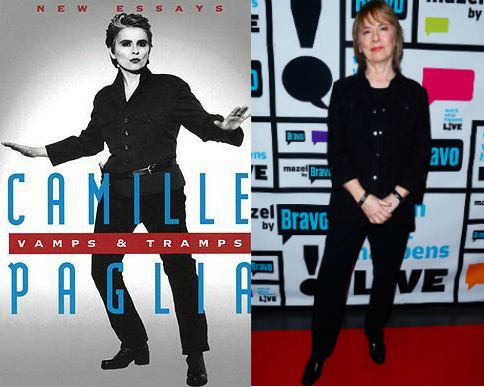I kept looking for as complete an autobiography as I could find, and realized that my presentation
Reclaiming Beauty: Saving Our Western Civilization (posted below) at the
Power of Beauty Conference, is as close as one I will find. I decided to present my "Reclaiming Beauty" presentation with me as a focus. My intention was far from narcissistic.
In a subversive way, I was trying to show that few (if any) non-Westerners would unequivocally champion Western civilization. I personally know of none, and would have found such a person by now (I've been writing about this for close to ten years now).
My point in the lecture was to show my own personal battle in this nefarious, multicultural world where this white western culture is maligned, constantly and viciously. Westerners are always put in the corner and forced to apologize: "Yes we built this...but look what we did in ..." in so many demeaning ways. I was trying to show that there is no need to apologize. I got, and still get, flak from family members and other acquaintances for these positions. It is not so much that I am a traitor but I'm reporting a
falsehood. Whites and the West are colonizers, exploiters, destroyers of cultures and countries. They are the cause of the world's malaise.
Think about the way ex-President Obama behaved: subtly superior, carefully maligning, always, and indignantly, against America however much he professes to be an American. In his "letter to the American People" as he left his second term
he wrote:
That, after all, is the story of America - a story of progress. However halting, however incomplete, however harshly challenged at each point on our journey - the story of America is a story of progress.
The "progress" is never complete. The past will never be expunged. The wound will forever be allowed to fester.
I wasn't gong to apologize for these truths, and no-one else should either.
---------------------------------------------------------------------------------
[Presentation at
The Power of Beauty Conference, Saturday, October 25, 2014.]
This is one of the first photographs of me after my family and I left Ethiopia.
 Champs de Mars, Paris. Six months after we arrived in France.
Champs de Mars, Paris. Six months after we arrived in France.
This picture was taken about a year before the terrible, and still damaging, “Ethiopian Revolution” when Emperor Haile Selassie was unceremoniously removed from his throne, and soon after, a vicious communist regime ran the country for almost two decades.
I am ten in this photograph. My brothers and I were in English-language French schools, since we knew no French having received our primary education in English.
We lived close to the Bastille, in the city-center. Ironically, this is the center where the French Revolution started. But, we were oblivious to these political turmoils. We had turmoils of our own: How to make sense of this new and bewildering country.
We often went to Champs de Mars, the park where the Eiffel Tower is located. We went there to walk in the garden, to ride the various carts and ponies, to eat some ice cream. Pistachio was my favorite.
From this photo, it is clear that I was still in some kind of shock over my new environment. I wonder what it was that had caught my attention? It looks like I was distracted from my quiet observations by yet another photo session, those photos which we would be sending around to show everyone we were dong fine in this new cty. Was it a little girl I was observing, perhaps one who could be a friend? People quarreling in that strange guttural language which I would soon learn to speak? A flower or plant I had never seen before? I don’t remember.
But this expression, and this curiosity, coupled with a deep desire to understand and make sense of my surroundings, has been my way of life ever since.
And Paris became my standard: For language, for food, for art, and for cities.
As I got used to the city, I became a devout museum-goer. Friends and families coming to visit us, would be told “Kidist can take you to the Louvre.”
I got to know Paris so well, and especially the older city-center, that I could get around through its small side-streets and alleyways. I would use the large boulevards for quick maneuvers to specific shops and locations and not for adventurous discoveries.
The juxtaposition of the small and intimate with the large that is so much part of Paris, became my standard for gauging a city. Wherever I went, I would look for the intimate and the grand. “This is how a city should be,” I thought.
It was in Paris that I got to love art, and Western art. Non-Western art was few and far between, and only occasionally would a visiting troupe of dancers or a theater ensemble come from an Asian or an African country. I don’t remember seeing any exhibition of African art. My informal education took took on Western orientation. And in my formal education, through my parents’ belief that it was better we learn English than French, and since my father’s UNESCO post paid for our primary and secondary education, my brothers and I were educated in British boarding schools, in the beautiful county of Kent.
By age eleven, I had acquired a Kodak Instamatic camera. Rather than take endless shots of family, pets (of which we had none anyway in our cramped Paris apartment, although I had two! dogs over my short life in Addis Abeba), or friends, I mostly used my films to take pictures of Paris: The Louvre, The Tuileries Gardens, the Seine, and here the Madeleine.
 View from Eglise de la Madeleine [Photo By:KPA]
View from Eglise de la Madeleine [Photo By:KPA]
Here, even then, in my juvenile amateurship, I seemed to know something about perspective. The view is from the steps of the Eglise de la Madeleine, and looks all the way down to Place de la Concorde.
But Paris is a dictator. She tells us exactly what we should be looking at, and what we should be taking. Such a confident city! So sure of her beauty! That was when I began to form my ideas about beauty. I realized, or internalized the idea, that beauty takes time, that it has its standards, and that people love beauty. The same way that they love Paris.
 Paris from our balcony [Photo By:KPA]
Paris from our balcony [Photo By:KPA]
(I had a Parisian friend in Toronto, who just couldn’t bear to be apart from her beautiful city. She was too polite to say that she couldn't find Toronto beautiful, but she compared everything with Paris).
Fortunately, I was never like her. Firstly, because I had seen other beautiful places, however different they were from this enchanting Paris. My young school years were in England, in the lovely Kent valley, then in the port city of Dover, with the spectacular White Cliffs, and the volatile and at times dramatic English Channel.
 Cliffs of Dover and the English Channel [Photo By:KPA]
Cliffs of Dover and the English Channel [Photo By:KPA]
I saw that there was beauty in other environments. That nature could be beautiful also, and leave us as enchanted as cities like Paris.
By about fifteen, while in Dover, I had graduated to a better camera, where I could focus, adjust the focal point and shutter speed. The cliffs deserved better! And I joined a photography group at school. My first “real” photograph, which I shot, processed and printed myself, is of the doorway of the school’s library. This was probably my first real attempt at making art.
 Dover College Library [Photo By:KPA]
Dover College Library [Photo By:KPA]
While taking this photograph, I deliberated whether the door should be closed or open, and decided on “half open.” The the next pressing issue was from which angle to take the shot: From the side, from the front, from afar, from nearby. I didn’t realize then that this was all about “composition.” Then finally once taken, the photograph had to be developed, and the decision became how I would print the picture. Should I darken the door? Should I crop the top? Is there enough contrast in the bricks?
It became clear to me that image making is a long process, with many points of deliberation. So the image being taken better be worth all that trouble!
While in England, although I never won an art prize, or even streamlined into the arts (I entered the sciences), I still participated in the school drama and music activities, all separate from the academics. I was in school choirs all through my high school years, and I won the music prize and received the complete Mozart’s piano sonatas, the musical notes, that is, not the records! I studied and performed at least one of them. And I received the poetry prize one year, and through the gift card I received, I chose a book on the impressionist painters which had so impressed me while I acquired my informal art education in Paris. I even won third place in a ballet competition, for which I received a tiny, but cherished book on the fundamentals of ballet.
 Dover College School Choir
Dover College School Choir
Then, following another of my parents’ idiosyncratic decisions, I went to America to continue my post-high school studies. I went first to a college in the mountains of the Susquehanna valley. There I was surrounded by nature, but different from the wild English waters. This time, it was undulating valleys and mountains, which became my focus on, and no longer the city (for now, at least). I became an expert bike rider, and would travel through the farms in the quiet country roads, surrounded by those mountains.
 Bike ride through the Pennsylvania countryside
Bike ride through the Pennsylvania countryside
 Susquehanna Valley [Photo By:KPA]
Susquehanna Valley [Photo By:KPA]
 University of Connecticut, with the Nutritional Sciences building in the background
University of Connecticut, with the Nutritional Sciences building in the background
But then I discovered another city, New York City. I had various relatives who lived there, who like us had left Ethiopia during those years of turmoil, and I would stay with them during the holidays, since my parents still lived in France. Its size, and lack of the intimacies that Paris offered struck me at first.
But I loved the grand avenues, those infinite perspectives both horizontal and vertical, the friendly, energetic people, the largeness of everything, including the museums, which I proceeded to visit. This was another confident city, confident in its unique identity. Paris was never on the lips of New Yorkers. Who wants Paris when you’ve got New York?
And I saw the charms of this city. Despite its largeness, it is very much a city of neighborhoods, offering intimacy in its coffee houses, the side streets, uptown or downtown, east or west. There were neighborhoods, where each had its own character. Looking up at skyscrapers, I noticed the care and attention they got from their architects and designers, despite the chances that few people will look up to notice the details.
 Details of skyscrapers [Photo By:KPA]
Details of skyscrapers [Photo By:KPA]
 Balloons on Wall Street, 4th of July celebration [Photo By:KPA]
Balloons on Wall Street, 4th of July celebration [Photo By:KPA]
 Riverside Drive [Photo By:KPA]
Riverside Drive [Photo By:KPA]
I began to understand that beauty, and beautiful objects, had to exist whether they were noticed or not, since they add to the overall dignity and aesthetics of their surroundings. People can
feel beauty.
 Northern Spirit: Toronto's Harbourfront [Photo By:KPA]
Northern Spirit: Toronto's Harbourfront [Photo By:KPA]
When I arrived in Toronto, during the vicious period of the Marxist government in Ethiopia, when my parents decided that we would never go back to Ethiopia, I abandoned my “formal” education and training of the sciences, and took on, finally, my formal study of the arts, first by enrolling in the film and photography program in Ryerson University, in Toronto, and then taking several years worth of drawing, painting classes at part-time, night courses, until I finally landed on textile design. But was well prepared for this, since all through my formal education of the sciences, I had been informally studying art: Taking courses in photography, dance, theater, and eventually painting and drawing.
But never graduated from my film/photography (BS) program, leaving when I had one year to go. Once again, I took the informal route for formal art studies. If I had enrolled in drawing or painting courses in a university, I would have left with little skill or capability, given the anti-art anti-technique mood that had started to permeate through colleges and universities for of "post-modern" rhetoric. Instead went to "night school." My night school teachers were adept artists, but the modern world of non-art had rejected them and their talents, leaving them to scrape along a in fiercely negative climate. One may say that this has always been the lot of artists, but I think that our era is especially vicious and destructive.
I thought I had finally landed in my field in textile design, and I thought I had nothing more to worry about, other than to learn this craft, and produce my creations.
But no. One of the biggest challenges I faced, and which I naively and bravely fought off, was people’s insistence, or assumptions, that I would do something “Ethiopian.” It was too long for me to explain that I had no real, physical or even emotional attachment to the country. But, that shouldn’t matter in Toronto, the epicenter of multiculturalism! Indian and Chinese students, who were born in Canada, spoke fluent, accent-less English, who were wearing the latest MTV costumes, were churning out their “Indian/Chinese/Vietnamese/etc.” heritage pieces, and gaining high praise.
Finally, as I had always done, I retreated into myself, left behind teachers' advice to “do something Ethiopian.” I set up a mini-studio in my mini-apartment and developed my grand ideas.
I produced works on the landmarks around me: the Allan Gardens Conservatory; the triangular shapes of the Toronto gables; the reeds alongside Lake Huron; small spring flowers; large lilac bushes. And finally, the national flower of Canada, the trillium.
 Toronto Gables [Design By:KPA]
Toronto Gables [Design By:KPA]
 Allan Gardens Conservatory [Design By:KPA]
Allan Gardens Conservatory [Design By:KPA]
 Lake Huron [Design By:KPA]
Lake Huron [Design By:KPA]
 Lilac Bush [Design By:KPA]
Lilac Bush [Design By:KPA]
 Trillium and Queen Anne's Lace [Design By:KPA]
Trillium and Queen Anne's Lace [Design By:KPA]
But it wasn’t just a matter of creating these pieces. I spent hours bent over design and drawing books to teach me how to reproduce these images through ink, pencil and paint, which the clever but clearly unskilled textile design teacher wasn’t able to do.
And it was while I was doing the Trillium piece that many things came together.
Art needs to be local. We need to “see” what we’re representing. That art needs to have an aesthetic dimension - it has to be beautiful. And that there is a spiritual dimension to art, not always, not aggressively, but still subtly and present.
I realized that modern artists were discarding these elements, and creating works that people couldn’t identify with. That their purpose was not to create works with beauty, rooted in reality and with a transcendent element, but to recreate their own godless transcendence, their own reality, and they were discarding beauty as something frivolous which distracted from their own serious messages, usually of doom and gloom. The less talented of them went on with post-modernism, which was a distorted assemblage of objects to produce their “ironic” commentary on the world around them.
And multicultural artists were throwing away the reality that surrounds us, in Canada, and were bring in their own reality for their far-away lands, imbued with a strange and alien aesthetics.
When I put these two together, multiculturalism and modernism/post-modernism, I realized what was at stake here was the art I know, which I have studied and participated in from a very young age ever since my fateful journey to that most beautiful city. It was Western art that was at stake, made vulnerable by these aggressive demands. “Hey, hey, Ho ho, Western Culture’s Gotta go.”
I didn't clearly articulate this then, but soon after, I started a blog called Camera Lucida working on the words “Chamber of Light” where (rather immodestly!) I thought I could shed some light on the world around me. And a few years later, after many postings, altercations with readers, and a maturity of my thoughts, I started my blog (about a year and a half ago) Reclaiming Beauty.
I started the blog on January 1, 2013 (a new blog for a new year), and on February 5, 2013 I wrote at Camera Lucida:
I have started a new project. It is bigger than a website.
I hope to reclaim beauty from the avant-garde, nihilistic environment that surrounds us. Rather than fight it, I thought I would start a site that would be study of beauty, a critique our our current beautiless, or anti-beauty, environment, as well as a place to give and receive practical guides and accounts on how to acquire and reclaim the beautiful. I hope to have a list of regular contributors to the site, who will eventually become a part of a bigger movement.
And on September 29, 2013, I posted at my Reclaiming Beauty blog my proposal for a book, but with a bigger vision of starting a Beauty Movement:
My book Reclaiming Beauty aims to document the contribution that beauty has made toward our Western civilization, from the earliest records of God’s love of beauty, to a young child who sees beauty almost as soon as he is born. Our civilization thrived, prospered and matured because of beauty. Our great artists, architects, writers, philosophers and scientists have always referred to beauty with awe and wonder. It is in the modern era that beauty began to be undermined and eventually neglected by artists and other intellectual leaders.
Reclaiming Beauty will show that the abandonment of beauty leads to the death of culture, and eventually society. Modern man’s neglect of beauty has initiated the cult of ugliness, leaving us with bleakness and nihilism.
But, people want beauty. And they will surround themselves with some kind of aesthetic quality. Still, beauty is the business of the knowledgeable. The man on the street may be able to recognize beauty, but he would not be able to explain why it is beautiful. That is the task of the experts.
With Reclaiming Beauty, I aim to present my ideas, observations and analyses on beauty, and to provide a guide for recommendations on how to remove oneself from the nefarious influences of our beauty-rejecting world. This way, we can build a parallel world which will eventually form a growing movement of beauty-reclaiming individuals, who can start to shape a world where beauty is not minimized and rejected.
Reclaiming Beauty will be the first book on beauty to make a comprehensive, historical, cultural and societal review of beauty. It will describe the moment (or moments) when beauty was not only undermined, but eventually abandoned, as a paradigm of civilized life. Rather than attributing beauty to a Godly goodness, philosophers, writers and artists began to view beauty as their enemy, and as their nemesis. They saw God as a judge who would not let them do as they wished. In order to pursue the image of beauty they desired, they began to look elsewhere. They began to abandon God, and by abandoning God, they began to change their world, filling it with horror and ugliness.
I maintain that this was not their objective, which was merely to look for a different perspective on aesthetics. This realization may have come too late, and too weakly, from the cultural leaders, but ordinary people, who are most affected by these changes in worldview, are already incurring changes. But they cannot make useful inferences, and hence necessary changes. They still need an elite to help them materialize their desires and observations.
A new elite that is pro-beauty needs to take the cultural reins, to guide and return our world back to its awe and wonder of beauty. To this end, Reclaiming Beauty will add an element which no other book on beauty has attempted: guidelines on how to renounce this world of anti-beauty, and how to progressively bring beauty back into our culture.
The book will be a manifesto for concrete references to these basic ideas. Along with the book, a website will be developed that will be an interactive continuation of the book. On the website, members can post their original articles, shorter commentaries, articles and excerpts from other authors, and encourage feedback and comments from other members. At some point, this group can develop into a more formal society, which can meet in a physical locations a few times a year, building beauty societies, whose purpose would be to develop ideas and strategies for bringing beauty back into our culture.
Part of the book will revised versions of what I've been developing over a number of years in my blog posts at Camera Lucida, Reclaiming Beauty and Our Changing Landscape, and from my full-length articles from Kidist P. Asrat Articles.
All images that head the chapters will be from my own collection of photographs and designs. Some of these images can be found at Kidist P. Asrat Photographs and Well-Patterned. Others I will choose from my collection of photographs, mostly in negatives and prints. Others I will take as the project progresses.
Finally, I would like to acknowledge some people who have helped me define, and refine, my ideas:
Larry Auster
Writer at the blog:
-
View from the Right
Author of:
-
The Path to National Suicide: An Essay on Immigration and Multiculturalism
-
Huddled Cliches: Exposing the Fraudulent Arguments That Have Opened America’s Borders to the World
-
Erasing America: The Politics of the Borderless Nation
James Kalb
Writer at the blog:
-
Turnabout: Thoughts in and out of Season
Author of:
-
The Tyranny of Liberalism
-
Against Inclusiveness
Laura Wood
Writer at the blog:
-
The Thinking Housewife
Judith Hakimian
And for the organizers here at Steubenville, who made my trip possible.
 Cloisters, New York [Photo By: KPA]
Cloisters, New York [Photo By: KPA]










































